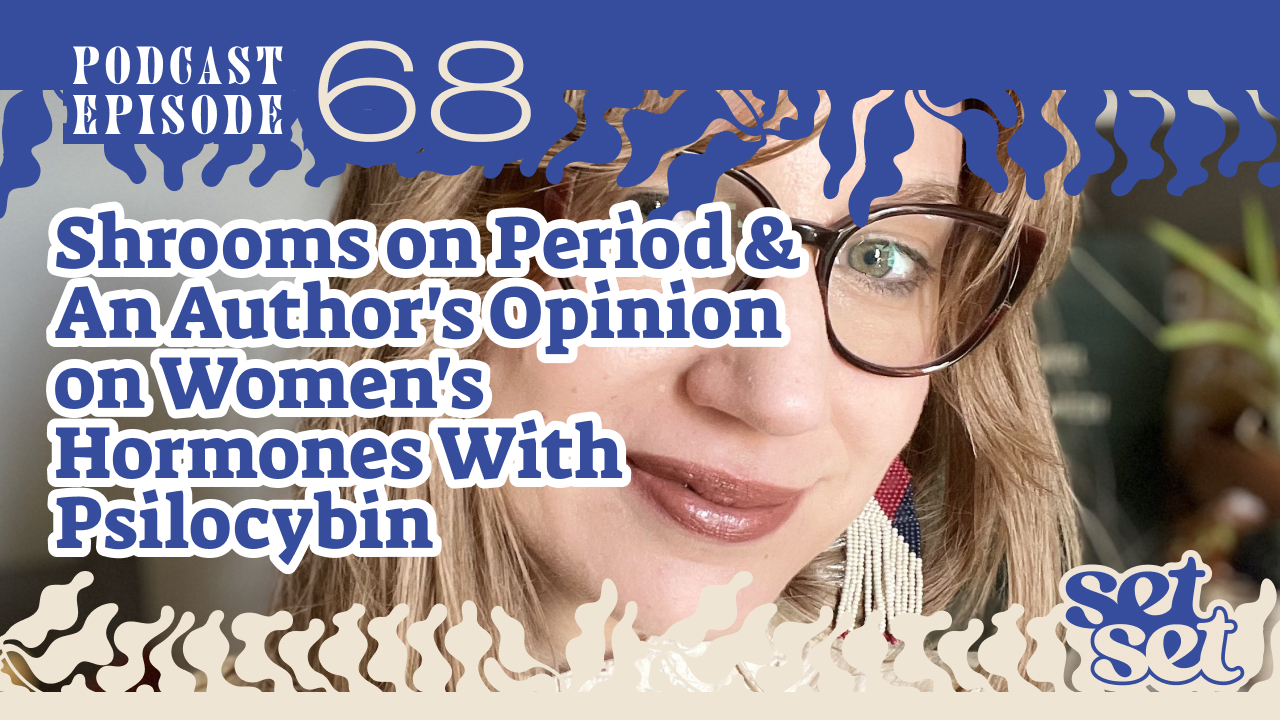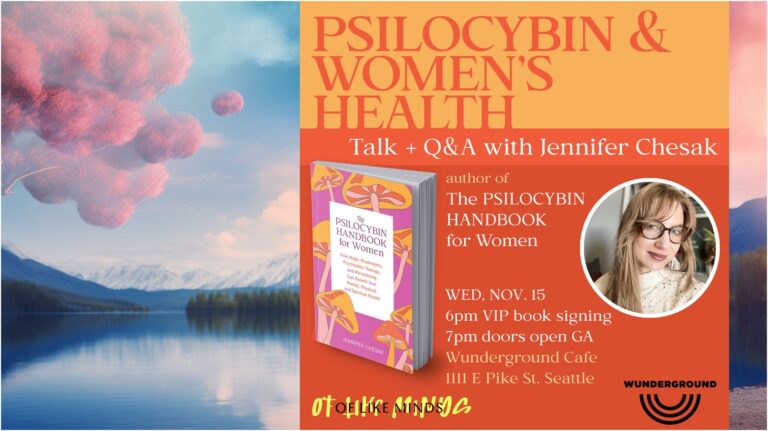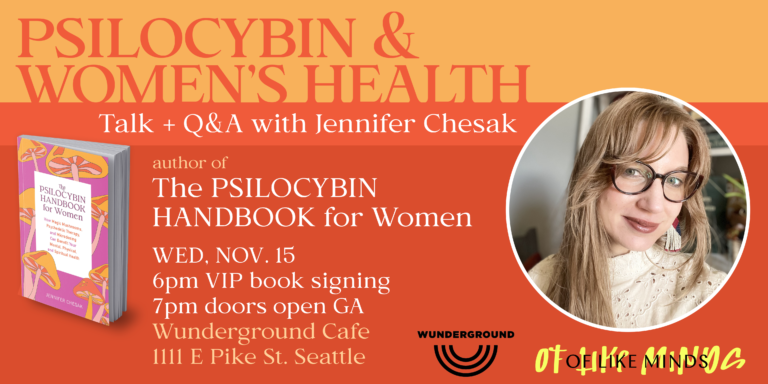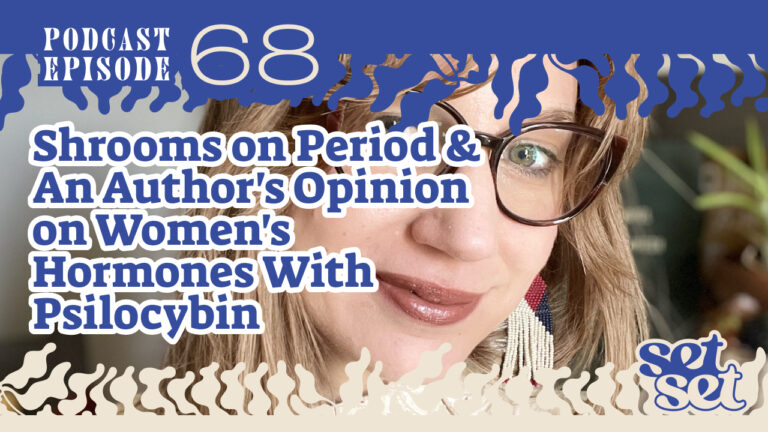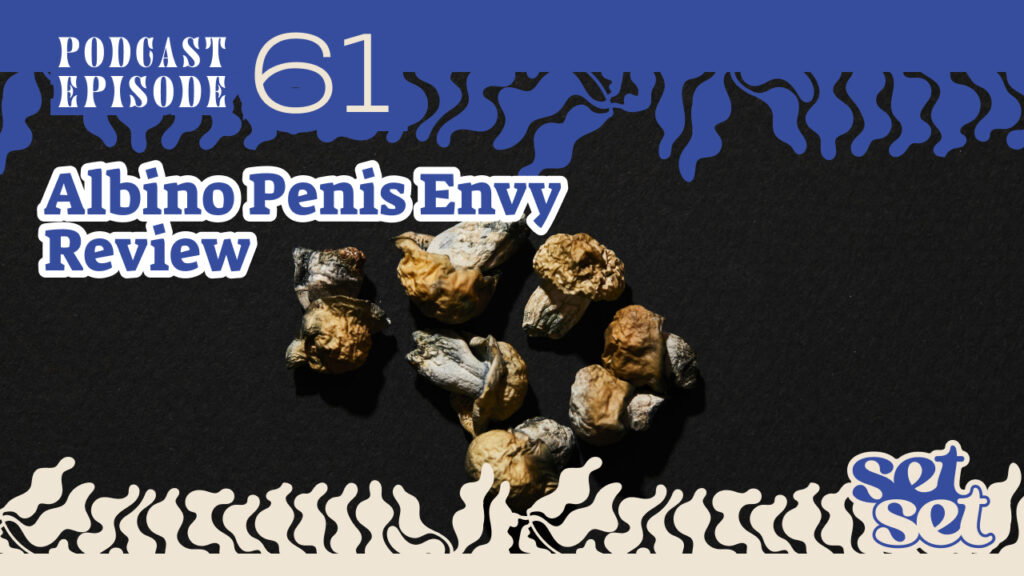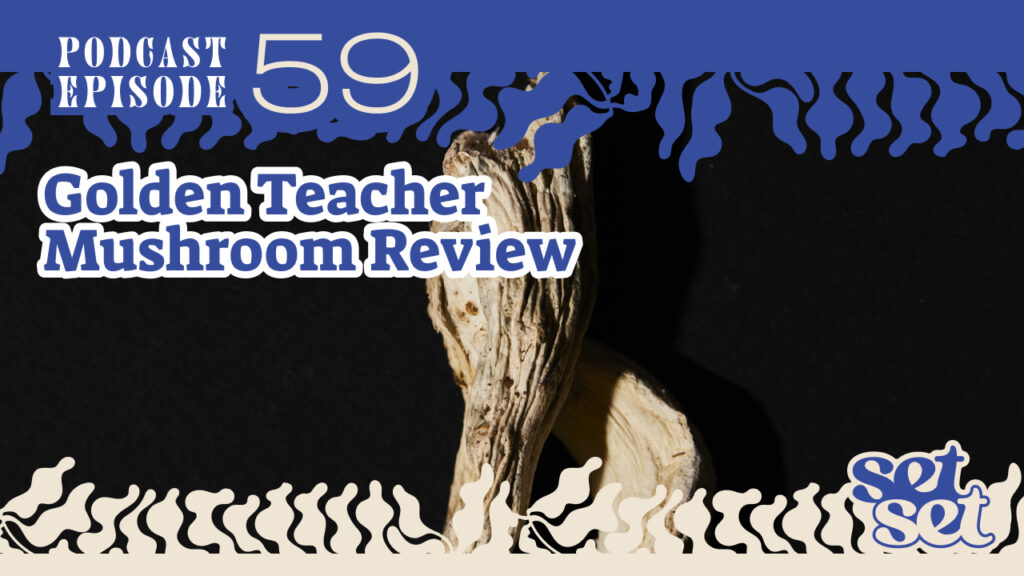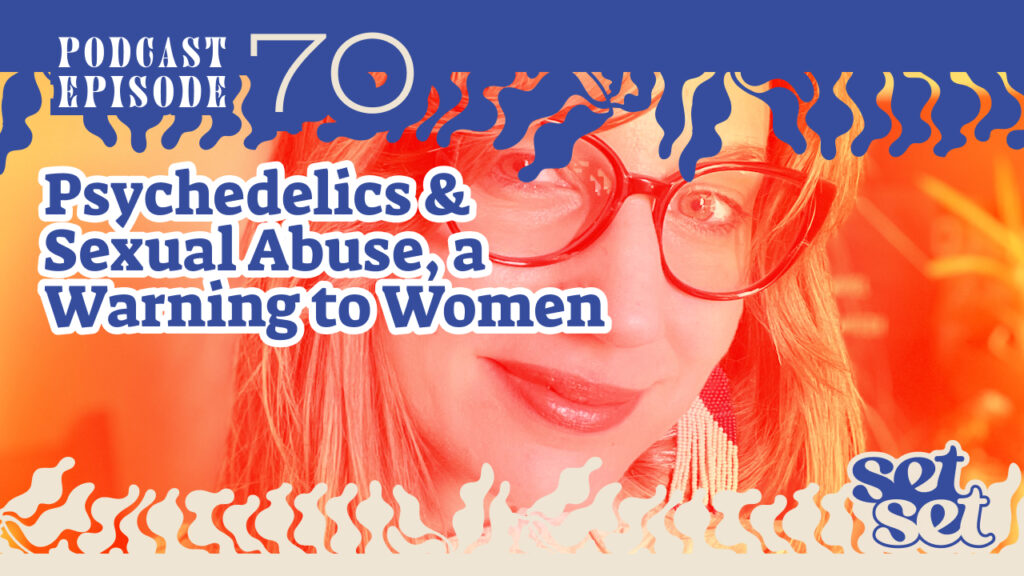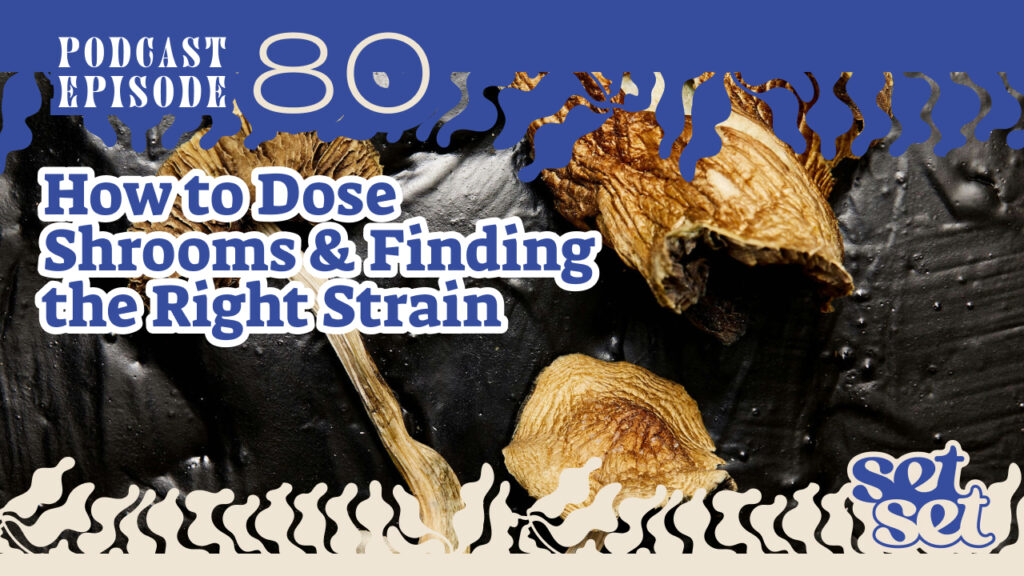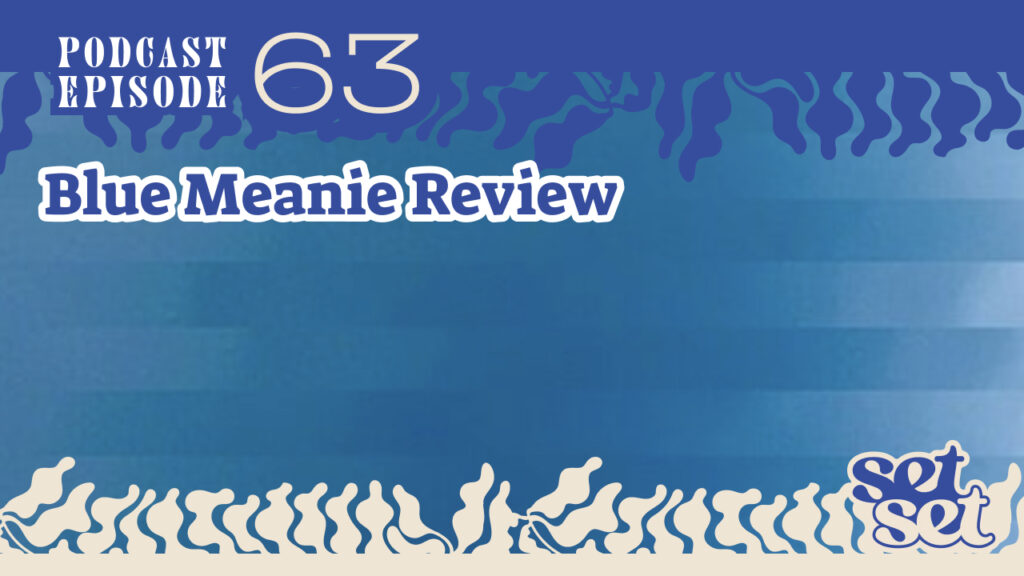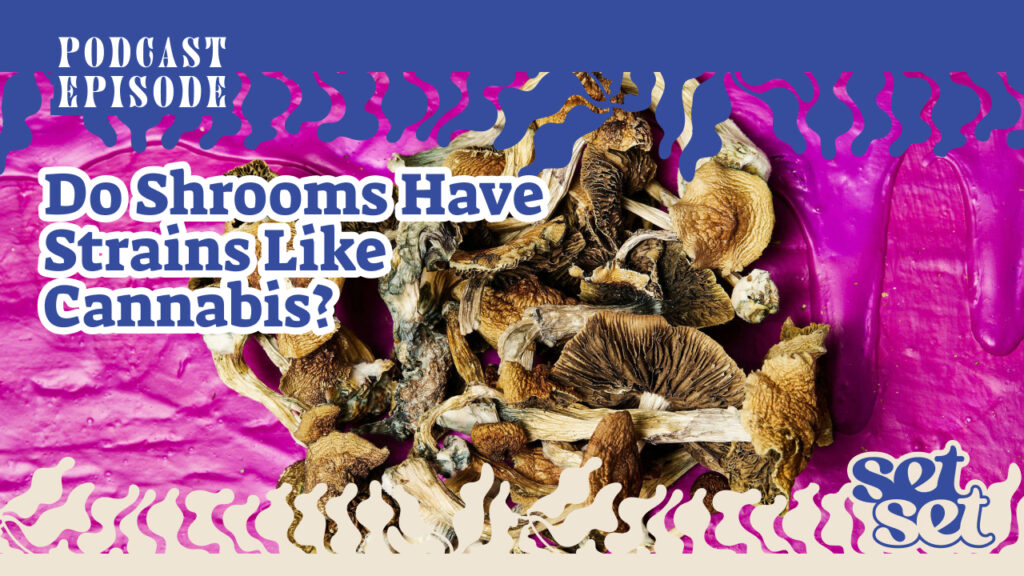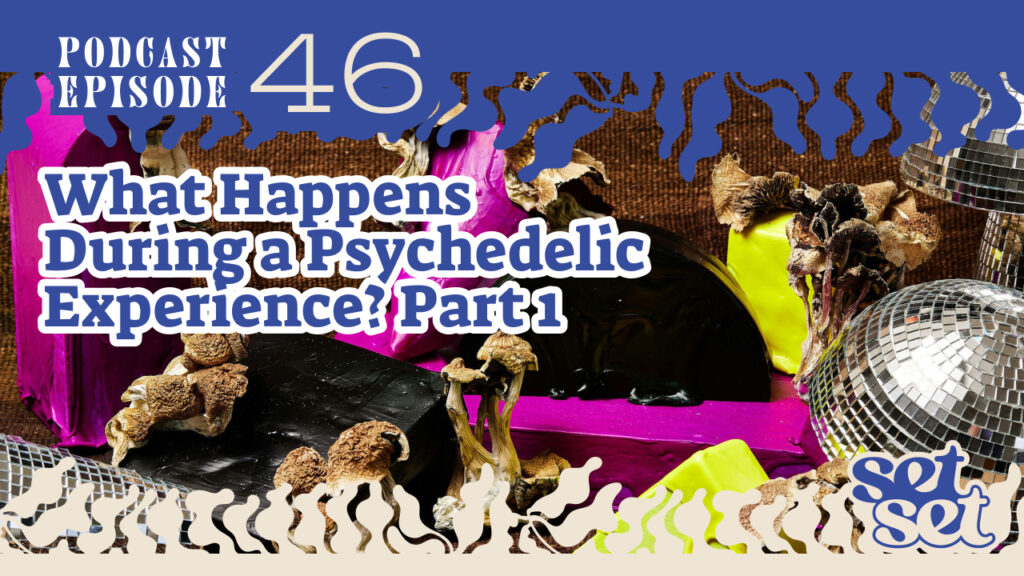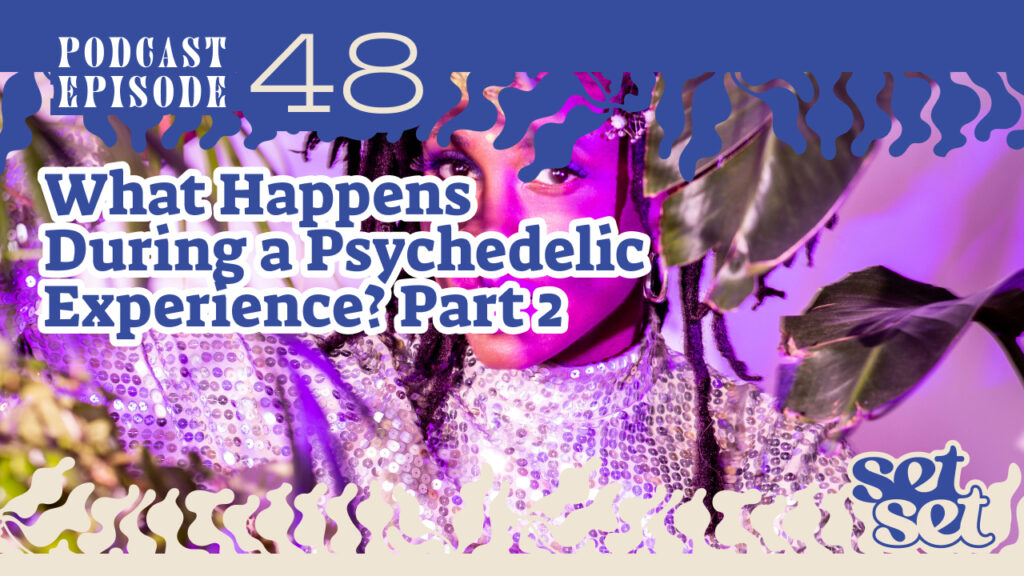April Pride, host: [00:00:00] Hey, it’s April Pride, your host here on the High Guide podcast. I’d like to take a moment to remind you that we do discuss cannabis and psychedelics, and this podcast is intended for audiences 21 and over. Also, I am not a medical expert. We do discuss interventions and protocols and you should consult your medical professional before moving forward with anything that we may discuss here on the show. Before we begin, I’d like to thank our show sponsor of like Minds. Check out OF LIKE MINDS to learn more about Seattle’s trusted source for psilocybin. Hi everyone. Welcome to the Hi Guide podcast. We’re back after a bit of a break with new episodes and a new show sponsor of Like Minds, Seattle’s trusted source for psilocybin products. Our guest today is Jennifer Chesak, a journalist who recently published the Psilocybin Handbook for Women and who will help us better answer the question Do psilocybin affect women differently? In this installment will commence with Jennifer’s personal narrative. Unpack the cannabis and psilocybin connection and uncover potential of psilocybin for conditions such as anxiety, OCD and substance use disorders. Over a series of three episodes, we’ll just scratch the surface of this topic, but have great news. Jennifer’s book is both big on information and style. I love the book’s cover, so don’t hesitate to pick up a copy for yourself. And I’ve linked to where you can in today’s show notes. But wait, there’s more. If you live in Seattle, our show sponsor of Like Minds is also sponsoring a live Q&A with Jennifer and me on November 15th. Details also in the show notes. Let’s get started. So if you could just introduce yourself how you’d like to be introduced on the show and give us some background. Like I love the introduction to your book. When you explain how you got here, your what happened with the Albuterol, any personal story that just helps give the listener context for why you should be a hi guide?
Jennifer Chesak: [00:02:26] I am Jennifer Chesak. I’m the author of the Psilocybin Handbook for Women, and I started writing about I’m a medical journalist and a fact checker. First, I should explain that. And so I started writing about psychedelics and specifically psilocybin for women. And the reason for that is because we really don’t have this full look or full picture the differences between men and women when we’re using psychedelics and with psilocybin specifically, that’s what I dove into. But I found it really interesting when I started doing this research and determining that, yes, I wanted to do this book specifically for women. And what I found was that via the Global Drug Survey, I think it was the 2020 Global Drug Survey, I realized that more women are using some psychedelics than men are. But what I did a little more digging because I found that fascinating, first of all. But when I did more digging, I realized that women are using psychedelics to self treat, whereas men typically use psychedelics to for recreational purposes. I mean, obviously that’s just a generalization and what was learned from this global drug survey. But it didn’t surprise me that women are using psychedelics to self treat. And that’s the reason that didn’t surprise me is because it seems like we’re super behind on women’s health in general. And part of the reason for that is that women were not included in early stage clinical trials until the 1990s.
Jennifer Chesak: [00:03:55] So I was a teenager then and you know, that’s really showing itself in different contexts. And one of the things that I like to bring up in relation to that, to illustrate how far behind we are, is to throw out the statistic and or not a statistic, but more some some facts here. And so in 1998, Viagra came on the market. So we had a drug for male sexual dysfunction in 1998. At that point in time, we did not even have a full picture of the internal structures of the clitoris. So that that didn’t happen until 2005, when a scientist, a woman, she dug into this and did some MRI imaging and then learned about the internal structure of the clitoris. So that happened in 2005. Then it wasn’t until 2015 that we got a drug for female sexual dysfunction. And so, you know, just to put that into context one more time, 1998, Viagra 2005, we finally get a full picture of female genitalia. Then it wasn’t until 2015 that almost two decades after Viagra, that a drug for female sexual dysfunction came out. So I know we’re going to talk about sex and psilocybin a little bit later, but I just love to talk about that timeline just because it is so alarming. So we’re very far behind.
April Pride, host: [00:05:21] Right. I think that sets up the conversation perfectly. Yeah. And the other thing is, when I looked through the book at some of the conditions for which psilocybin is being used, I thought you also set that up quite nicely because you said there are conditions that we’re treating and then there are symptoms that are related to the root condition that are also being treated by psilocybin. So if you could talk a little bit about this circular solution, I guess. Yeah.
Jennifer Chesak: [00:05:48] So I what I did with Chapter 11 in the book was I researched all the different conditions that psilocybin has so far been at least looked at in some respect. Doesn’t mean we have robust research, but at least at least we have some. And then I looked at which conditions either only affect people assigned female at birth or disproportionately affect people assigned female at birth, or affect people assigned female at birth differently than they do men. And the example that I give of the difference would be something like smoking cessation. I mean, I know that’s not a condition, but it’s something that people often are trying to do is to quit smoking. And for women, it’s interesting, females have different nicotine receptors than men. So if you look at all of the smoking cessation products out there, the large bulk of them, they all rely on dealing with the nicotine receptor to help wean you off of nicotine. But women have different nicotine receptors. So these products aren’t working very well for women when they’re trying to quit smoking. So, you know, and psilocybin is being looked at for smoking cessation, which is kind of interesting, too. So that just gives you an idea of the difference that sometimes occurs with men and women because, hey, we have different bodies and the medical system treats us all the same. Ain’t half the time or they have historically and are starting to move in a different direction with that, adding women to clinical trials and trying to split it as evenly as possible. But there’s still a problem with us just not having a whole lot of research that’s really focused on women. But yes, you’re correct. I was looking at not only conditions, but symptoms related to conditions. So endometriosis is a systemic disease. I have it. And it a lot of people have chronic pain. So chronic pain is a condition of that or a symptom of that. And chronic pain is a symptom of migraine and things like that. So I dive into all of that in Chapter ten.
April Pride, host: [00:07:46] So two of the two of.
Jennifer Chesak: [00:07:48] The condition I’m.
April Pride, host: [00:07:49] Sorry, Chapter 11. Yeah. Two of the conditions that you mentioned, endometriosis and migraines and the pain that comes along with endometriosis are symptoms that I’ve talked about for years being treated with cannabis, right? So where does cannabis stop and psilocybin pick up in terms of managing these conditions?
Jennifer Chesak: [00:08:08] Yeah, I think that’s really interesting. I think there’s some overlap for sure in terms of cannabis and psilocybin with managing these conditions. I do think that cannabis is going to be more beneficial for things like chronic pain. So I use cannabis regularly to stave off migraine, stave off endometriosis, pain and things like that. Where I think I mean, I think psilocybin may have some applications for chronic pain that’s being studied right now, especially having some anti-inflammatory effects and doing some different things with the brain that are related to chronic pain. So I think there’s some some overlap there in terms of cannabis and psilocybin. But I think where psilocybin tends to be much more beneficial with these conditions are when we’ve got conditions that are affecting the brain in specific ways. So I know we’ll talk about eating disorders, but that’s just that’s one condition or I should say multiple conditions, eating disorders, obviously. But those are conditions that where we’ve got some differences in the brain between people who have eating disorders and people who don’t. And so psilocybin, as we know, does do some changes in the brain, which is great. And so there’s potential to help there. So I think that’s the difference. The main difference here is that we’re looking at, you know, certainly cannabis can help relax. You ease chronic pain. And then we look at psilocybin. It can probably do some of those similar things, but also with conditions and things like that. It may actually make changes in the brain that are longer lasting, if that makes sense.
April Pride, host: [00:09:42] Eating disorders, though, that that’s a good one, right? Because I know women, including myself, actually, I take stimulants daily, so cannabis helps me get excited to eat right because I need to eat three meals a day no matter what. And I did have an eating disorder in high school, so I have to be really careful taking something that suppresses my appetite. And I’ve talked to so many women who have had similar life experiences as me and cannabis is something that gets them often say I’m not very motivated by food. And so it’s just something that really does help and stimulate your appetite, right? So that could be one way that cannabis can help someone that potentially has disordered eating in some way. And then with psilocybin, I think this is a really great example of I often say that cannabis helps with the symptoms and it feels like not just psychoactive drugs, but psychedelics help with the root cause of what may be leading to those symptoms. So there may be something there. And I’d like to continue actually with this eating disorder conversation, because we had a live event here in Seattle on Tuesday and eating disorders came up because the same treatments have been used for decades and it’s not working. It’s really about you’re doing something wrong. You need to reset your relationship with food and how you take care of yourself. It’s a lot of you’re not doing this right and we’re going to teach you how to do it because once you do it, you’ll feel better. When or if we what we know about the brain and what’s happening with disordered eating. There’s obsessive compulsive at play. There’s neuroticism at play. Like, I feel like your book just does such a good job of trying to outweigh the complexity of it and how psilocybin just goes straight into we can break this loop of very regimented thinking, right? That’s where they’re thinking psilocybin comes in and breaks that loop. Can you talk a little bit about that?
Jennifer Chesak: [00:11:36] Yeah, absolutely. So I’m really excited about some research that is coming out eventually. It’s in the works right now on psilocybin and eating disorders and really specifically looking at anorexia with anorexia, it seems like there’s some abnormal activity with serotonin receptors. And with the anorexia, there’s that. And also a reduced concentrations of what is called brain derived. Neurotrope neurotrophic factor. I always have trouble saying that. And so these things may play a role in contributing to anorexia. They the researchers really need to dig into this a little bit more. Brain derived neurotrophic factor is protein and has a lot to do with our neurogenesis. So how our neurons are doing and our brain and things like that. And so we know that psilocybin binds to serotonin receptors and enhances Bdnf expression, which is. So that shows some promise with anorexia and also with anorexia, we have this situation where we’ve got a lot of cognitive cognitive rigidity and emotional avoidance that are probably there. And so a psychedelic experience can typically, positively impact these traits. So also people with anorexia nervosa have this what’s it’s an increased connectivity between resting state functional networks. So when we look at something like the default mode network, which is a network of brain regions that all work together and they do that to form our sense of self.
Jennifer Chesak: [00:13:12] And so it seems like we have increased this in anorexia. There’s this increased connectivity between the default mode network and what is called the angular gyrus. And so that increased connectivity is associated with these issues regarding what would be called interoceptive awareness, and that is our awareness of essentially the internal states of the body. And so we may have I mean, maybe that’s related to what happens with body dysmorphia, which is very characteristic different eating disorders. But what we know with psilocybin is that it decreases this connectivity of the default mode network. And so by doing that, we kind of, you know, release this connectivity that might be driving the eating disorder. And then also so psilocybin decreases amygdala reactivity. So researchers are saying that that that also might play a role with anorexia. And so because the amygdala plays a role with that. And so we may have less emotional reactivity to food and body related cues once we’ve done a journey on psilocybin, if that makes sense. Again, we need a lot more research on this, but I’m excited to hear that researchers are studying this because I do think that we’ve just kind of touched the tip of the iceberg.
April Pride, host: [00:14:43] I want to take a minute to explain a term that might be new to you. Whole fruit bodies. Mushrooms have these amazingly intricate underground route networks that are a big part of what make mushrooms magical. The fruiting body is the part of the mushroom we see above ground, the cap and the stem. And those are the parts that make magical mushrooms magical. For the true romantics who want to experience the purest form of psilocybin, our whole fruit bodies, which are carefully dried and sold by the eighth of an ounce, are the way to go up like minds. Fruit bodies are cultivated and sourced in Seattle, where of like minds is based. It’s important to us to work with trusted partners. That’s why our whole fruit bodies come from the same guy who helps us create our amazing caramels. All of our fruit bodies are cultivated in Source in Seattle, where of like minds is based. It’s important for us to work with trusted partners. That’s why our whole fruit bodies come from the same guy who helps us create our amazing caramels. Now let’s talk strains. We’ve got three excellent varieties of magic and our whole fruit bodies collection. There’s the potent and intriguing penis envy, the gentle, inviting hillbilly and the captivating Ecuador. Each strain offers a unique experience tailored to different preferences and explorations that we write about in depth on our website. We do understand that not everyone wants to chew on a dried mushroom. Maybe you’ve got a sensitive stomach or you prefer a different taste profile to dried up dust.
April Pride, host: [00:16:18] So I do want to mention that we also make scrumptious chocolate covered psilocybin caramels. We make microdose offerings. If you’re new to the world of psychedelics and just want a more subtle approach. So whether you’re seeking the purity of whole fruit bodies or the convenience of taste of an edible, or if you’re looking to take baby steps into tripping via microdosing, the of like minds website is a place to go to get started. Explore a range of offerings. Read up on the experiences of others. And if you live in Seattle, you can of course purchase one of our educational downloads. And as your gift with purchase, you will receive shipped via third party carrier a gift from of like minds to you at your Seattle address. Sign up for the Ublic Minds newsletter and follow us on social media at Ublic Minds Co for all the updates to learn all the ways we are all of like minds. Anorexia is a very isolating condition disease, right. And so when you are suppressing your when you’re quieting your ego, when you’re not just thinking that every single thing that goes right or wrong is your doing right, when you can get out of that thinking. And so you’re trying to control your eating because you’re everything else feels out of control. It just I mean, it just makes so much sense to me as a treatment. I can’t wait to see what the results are, really.
Jennifer Chesak: [00:17:51] I agree. I think it makes a lot of sense to all the theories behind it. So I’m sure that what we’ll see is that the research eventually supports some of that.
April Pride, host: [00:18:00] So, you know, we could talk all day about research, lack of research, what the research actually says. But one of the most important things in your book is the fact that there’s so much to be learned from indigenous cultures who don’t necessarily have science to back up what they know. These medicines, what psilocybin specifically can do for women specifically, right? So one of the things I learned in your book is timing your psilocybin journey with your ovulatory cycle. And since I read that and I’ve been talking to other people about it, there is a huge amount of interest in understanding that better. And I know your book does a great job of going into the details of that. And so I would recommend that all listeners buy the book if there’s a place that you specifically want them to buy the book, I’m going to make sure that link is in the show notes. And again, the book is the Psilocybin Handbook for Women. If you could just talk a bit about what you learned about Two-eyed seeing and where there’s a lack of research, what information we do have in terms of turning to psilocybin with women in their cycle.
Jennifer Chesak: [00:19:08] Yeah, absolutely. Such a great question. And so Two-eyed seeing is a concept that a social worker name is Natalie Vilanova. She was telling me about this and she also had this in a poster presentation at a conference that I was at. And I was just like, Tell me more about this. And because I had never heard of it before, but two eyed seeing is a it’s a concept that was first introduced to the mainstream, we’ll say, by Micmac Elder. His name was Robert Marshall, and he was of the Eskasoni First Nation. So he’s the one that first brought this to mainstream. But the concept is similar to what it sounds like really, is that we have this trove of indigenous wisdom out there because people, indigenous people have been using psilocybin for thousands of years, you know, well before white people even knew about it, right? And so we have and so we think of science as this thing where you do something over and over to produce the same results. And then we call this science. Once we get the research solidified and whatnot. Well, indigenous people have been doing that. They’ve exactly been doing that. They’ve been doing something over and over and over to get these same results. You know, they’ve been studying it. It’s just not in the way that we think of as this very specific scientific method.
Jennifer Chesak: [00:20:30] So it’s we need to be blending not only the scientific research, but also the what we know from indigenous wisdom. We need to be blending that when we talk about psychedelics because they are sacred substances. So that’s a good point. But also again, people have been doing this as practice for so long. We have knowledge from that, even if the research isn’t showing this yet in that scientific method way. So with the with the menstrual cycle first, I just kind of want to mention the the possible interaction. So the menstrual cycle occurs along what is called the hypothalamic pituitary gonadal axis, or sometimes people call it ovarian axis. So I’m just going to go with HPG because that’s typically what it’s called. So this HPG axis controls our menstrual cycle. And what I mean by controlling that, it’s that one hormone raises, it tells the different parts of that axis to release the next hormone and such. And that all creates that trajectory of the menstrual cycle that we know. In terms of the follicular phase, first we’ve got ovulation in the middle and then followed by the luteal phase. And then at the end of the luteal phase, you get you menstruate essentially. So that’s the gist of the menstrual cycle.
Jennifer Chesak: [00:21:45] But we also have an axis called the hypothalamic pituitary adrenal axis, and that’s where our stress response is. So that’s a lot of where the serotonin receptors come in. And so when we take psilocybin, that really activates that HPA axis, the hypothalamic pituitary adrenal axis. So researchers are finding that there is some overlap there of those axes. One can impact the other. So theoretically, as we activate psilocybin receptor serotonin receptors, if we as we activate serotonin receptors, we were certainly. On that HPA axis and that can impact the HPG axis. So there’s a lot of axis going on here. But what I wanted to do was find out. So we’re thinking that there’s an impact and there’s some research coming out about that, but we don’t know all the specifics regarding psilocybin and then how that affects the menstrual cycle. Yet we’re learning some cool things such as that. It can help regulate the menstrual cycle. Perhaps, again, more research is needed, but we do have indigenous wisdom. So getting back to this two eyed seeing concept, I talked to a woman, her name is Micaela de la Miko. She goes by Mama de la Miko on Instagram and she’s super knowledgeable about psilocybin and the menstrual cycle. And what she had recommended was that we should be when we’re doing when we’re considering a deeper trip or a trip in general with psilocybin, that we want to do that during our ovulatory period.
Jennifer Chesak: [00:23:11] So kind of the middle of the cycle rather than closer to menstruation or during menstruation. And the reason for that is because we need more nutrients towards the luteal, the end of the luteal phase. Whereas the ovulatory phase are we have a lot of energy in our bodies. And so a lot of people in psilocybin sessions will fast a little bit before the psilocybin session. It might be a period of a few days or just one day, or you kind of reduce the amount of food that you’re eating and that can perhaps enhance a trip. But we’re finding and this stuff makes sense in terms of what she is saying. And the reason that it makes sense to me is because I’ve done a lot of research on the cycle in general, and in that luteal phase, we tend to become more insulin resistant. So I won’t go into all of the what insulin resistance necessarily is, but that can drive our cravings because we’re our bodies are trying to send all these nutrients to what would be a fetus essentially, or an embryo or whatever you want to call it, if there is one. So our bodies are doing that in the luteal phase.
Jennifer Chesak: [00:24:21] And so that is why, again, why we have cravings during that time. But at ovulation, we don’t necessarily have that because we haven’t entered that state of insulin resistance yet. So I think that that we’re going to find out more of this information in terms of just cycles in general explaining why are we having all of these cravings? Why do all these things happen? Why do we get a migraine near the end of the cycle there? But we’re also going to find out more information about how the proper or the the best practices in terms of psilocybin and our cycles. The other thing that Mama de la Miko told me that I found fascinating was so obviously there are different microdosing protocols, but if you’re thinking about engaging a microdosing protocol, she recommends that if to start whatever protocol you’re going to do and maintain it for about three months so that you go through essentially three cycles to see how it is working, keep a diary perhaps on what what’s happening in your body, any changes that you note. And so, yeah, that’s kind of what her recommendation was and it seemed to make a lot of sense to me just based on science research that I’ve done on the cycle.
April Pride, host: [00:25:33] Do you microdose have you kept a journal? Did you do you may not have a need to, but just curious.
Jennifer Chesak: [00:25:38] Sure. So I’m not currently doing a lot of microdosing I’m doing occasionally just kind of following my intuition with that and taking a small dose, but not a lot. And so I’ve only, you know, I’ve done a large, deep trip, but that had a lot of really positive effects on me and I haven’t felt the need right now to do a deeper journey. So just kind of again, using my intuition on what does my body want for me.
April Pride, host: [00:26:04] I want to thank you. Yeah, I just want to clarify something. When you said that we should time our psilocybin trips around the Ovulatory phase because we’re more insulin resistant, is that because it will be harder for us to not eat in preparation for a trip and they’re trying to make that easier? No, that’s not.
Jennifer Chesak: [00:26:26] Oh, no, no, I’m sorry. Certainly that aspect of of fasting kind of plays into that for sure. You’re going to have a hard time fasting. It’s not necessarily recommended to be fasting around your as you move into your your menses essentially, so that insulin resistance, there could be things going on in terms of the that stress response that that’s a little bit more heightened during that time. There’s a potential for that and so we may have a more pronounced trip experience, perhaps a negative experience. You know, it varies per person. It’s just kind of recommended that that ovulatory period is the better time based on that. But I was bringing up that insulin resistance just basically because it’s going to be harder to fast. And I think fasting is beneficial before a psychedelic. Session specifically for before psilocybin. Okay.
April Pride, host: [00:27:22] Yeah. So there are a couple of reasons why it makes sense to do it. Smack dab in the middle. Yeah, I mean, anecdotal evidence, but whenever I have taken not just psilocybin, but even MDMA, I start my period early. I started the night that I take it and I’ve heard from so many women that that that is true. And I think I might have read in your book that there might be a reason for that. We just don’t really know quite yet. But why it can bring your period on. Do you have anything to add to that?
Jennifer Chesak: [00:27:46] Yeah, I think so. What’s really fascinating now is that people are studying this. So at Johns Hopkins Psychedelics Research Center that they have, they there are two women who are studying this and they did a couple of they did a case study essentially where they looked at three women who had used psychedelics. And they were kind of considering the impacts that that had on the menstrual cycle. Two of the women did use psilocybin. I think somebody else used something. The third woman used a different type of psychedelic. But these two women, they noted one had premenstrual dysphoric disorder. So Pmdd and the other had PCOS. So polycystic ovary syndrome. And they both of them had irregular cycles. And once they took psilocybin, they noted that their cycles came a little early and that So that backs up what you’re saying and that you’ve heard all of this from, you know, anecdotally from people. Yeah. What’s occurring. And then the other thing that they noted was that after this period of irregularity, their cycles became much more regular again. So that was really interesting. And again, I think that really has to do and researchers think this as well, that it has to do with that overlapping of the axis. So the HPG axis controlling the menstrual cycle and the HPA axis with your stress response. So we know that those axes do have that reciprocal relationship. Essentially.
April Pride, host: [00:29:11] Did these women do one macro dose and then it reset or were they taking micro doses or were they doing a combination? Know, I.
Jennifer Chesak: [00:29:19] Would have to pull up the research again to determine that. But I think they each had done a larger dose and then one continued to do some microdosing after that. So we don’t have enough research that actually, you know, with enough people to say that this is true or whatever. But it does appear that we’re seeing so many people online talking about this, that the cycle comes a little early and this more of a regulation after using psilocybin. So I think it’s really fascinating and I hope we do get some research about this that’s a little bit more solid at this point.
April Pride, host: [00:29:52] Well, one of the things that you touched on, that is the number one concern that our audience has, and that came up several times actually this Tuesday at our live event. And that is the idea of a bad trip. And I know that I bad trips get a bad rap and we should be calling them challenging experiences. You know, it’s in our it’s in the zeitgeist. We call it bad trips. Right. So and women, it looks like some of the data points to the fact that we are more likely to have a challenging experience. And it seems based on the conversation we just had, that that could have something to do with when you decide to trip where your cycle is.
Jennifer Chesak: [00:30:31] Yeah, I’m actually really glad that you brought that up. So there is some research about that. It seems that challenging trip reports are more common in people assigned female at birth. And so again, we need more research on that. But you know, the analysis that I looked at suggests that that people assigned female at birth may experience psilocybin even at different doses differently because of various hormonal aspects, enzymatic reactions in the body and even the social differences that we are, you know, exposed to. Again, we’re just we just have different bodies than the male body. And so I think there’s something to do with estrogen and psilocybin in terms of there might one might impact the other. So I think estrogen has an effect. Our level of estrogen may have an effect on our trip when we’re tripping. So it just depends on where you are in your cycle in terms of the level of estrogen that you have, because it’s kind of like a roller coaster in the cycle. And so that may have to do with so the reason that it might be better to do a trip in that ovulatory period may have to do with the way that that estrogen interacts.
April Pride, host: [00:31:46] Yeah, because I think estrogen is a serotonin antagonist. And so if you have more estrogen in your body and you have more serotonin in your body and then you add psilocybin to it, I think I’m going to have to get a medical expert in here to explain that all could mean because you kept talking, you would definitely want to fact check me. But yeah, I love the science and me trying to make sense of the science as a non scientist, it’s yeah, definitely fact check me. I’m very lucky to have people I can call to get some answers. Thanks. Join us for this first episode in conversation with Jennifer Chesak, author of The Psilocybin Handbook for Women. Stay tuned next week for the next installment in this three part series. And if you live in Seattle, then you’ll want to join Jennifer and me on November 15th for a live Q&A. Check out the show notes for this episode. For more information on tickets and we’ve link to Jennifer’s book. Thank you as always for listening to the High Guide podcast, and we’ll see you next time.

